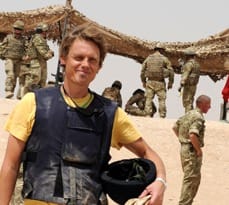Working on the Cam and at Camp Bastion, Dr Mark de Rond is turning the theory of teamwork on its head
 It’s one of the most well-worn clichés in business: there’s no ‘I’ in ‘team’. But research by Dr Mark de Rond, Reader in Strategy & Organisation at Cambridge Judge Business School, demonstrates there is indeed a place for the individual within a team.
It’s one of the most well-worn clichés in business: there’s no ‘I’ in ‘team’. But research by Dr Mark de Rond, Reader in Strategy & Organisation at Cambridge Judge Business School, demonstrates there is indeed a place for the individual within a team.
His book, There Is An I in Team, and his fieldwork with groups operating under high pressure – from elite rowers on the Cam to hard-pressed army surgeons at Camp Bastion, Afghanistan – has thrown up numerous questions that defy the conventional wisdom on teamwork.
Why do even highly effective teams often feel dysfunctional? High performers introduce risks – how can these be mitigated? When does it make sense to sacrifice competence for likeability? Why are teams best under-resourced? And why do problems arise in teams even when they’re not in conflict?
The answers are never simple. But Dr de Rond’s work is being used by numerous companies, including the McLaren Group, Stonehage and KPMG, to enhance their teamworking.
Steve Hollis, chairman of the KPMG Midlands Region, says a leadership development programme delivered by Dr de Rond and rooted in his findings had a considerable impact on partners’ team management.
In particular, the sessions empowered all team members to speak out and challenge the status quo.
This has been particularly beneficial, Hollis adds, given that it is the younger team members who are in a position to give relevant input on electronic and social media communication.
The Midlands region also had the fastest growing financial performance in the UK in 2012 – an outcome Hollis attributes directly to the application of Dr de Rond’s research.
“My work methods are very old-fashioned,” says Dr de Rond. “I study people by living with them full-time to try and tease out the subtle dynamics of teams of high performers.
These are not ordinary teams. Theses are people who are forced to work together under difficult circumstances. They might inhabit hypercompetitive environments, like the Cambridge University boat crew, where up to 40 people compete for only eight places in a Boat Race against Oxford.
Or a highly emotional environment, like the surgeons at Camp Bastion. They operate on people who are young and horribly injured, wearing the same uniforms as they do, or on young children as collateral damage of the war.
I live with them to try and understand how, when people are pushed to the extremes, they continue to operate effectively – or not.

It’s important to understand these dynamics. Many people, de Rond points out, have no choice but to work together. A surgeon or a rower can’t achieve anything alone but have to learn to coordinate perfectly with individuals very like themselves and with whom they also compete at other levels.
This kind of finely detailed, qualitative research doesn’t offer any easy generalisations.
But it can come up with new ways of thinking – such as, for example, recognising that tension within teams isn’t necessarily a bad thing.
“Sometimes tensions are best left alone because they exist quite naturally,” says Dr de Rond. “The teams I study are typically made up of people who are inherently competitive. That is how they got to where they are. To form them into a team and expect this need for rivalry to disappear is not realistic.
“In rowing, the only way to make a boat go fast is perfect coordination. You have to get eight people to synchronise. Even if you work harder than anyone else, if you lose synchronisation, you slow the boat down. So you effectively have an environment in which competition and collaboration co-exist and feed off each other.
People compete for places in the team, yes, but they can only compete effectively by collaborating perfectly with the people they are competing against. That’s an extreme case. But there are versions of this in most working environments.
And Dr de Rond is continuing to explore the idea of team performance under high pressure. He has just returned from his latest fieldwork project – being a member of the first-ever team to row the entire length of the river Amazon – which, he says, may bring more new insights.
“There’s a common assumption that harmony is a prerequisite for performance, so if you and I get along, the better we will perform,” he says. “By contrast, experiments in social psychology show that harmony is more likely to be the consequence than cause of performance. But the Amazon experience suggests that the relationship between harmony and performance in teams is subtler. These things are very complicated. Much of what I try to do is get a more subtlety and nuance in human behaviour.”

